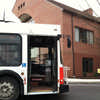Housing for the Elderly, Disability Access Design Issues, Mobility in Buildings
Low-cost Housing for the Aged
J.P. Morgan Library and Museum in New York City – article by Joel Solkoff, 13 Oct 2013
Oct 13, 2013
In this latest article by Joel Solkoff for e-architect he looks at housing access issues, stating that in the U.S. over 90% of housing is not wheel chair accessible and in the U.K. this figure is 92%. For people living independently, there is an absence of design professionals whose work could prevent accidents, and these preventable accidents can result in a permanent move to a nursing home. Joel also focuses on the requirement of elderly individuals to access spiritual growth, artistic masterpieces, and the ability to exercise creativity.
Low-cost housing for the aged and the Morgan Museum and Library
My father conducted a sit-in in 1945, the year my parents married.
My father, whom I called Isadore, Izzy, and Dad interchangeably, was a conservative man and an attorney.

photo by permission Isadore Solkoff Historical Papers
Low-cost Housing for the Elderly
Few events would provoke him to extremes. One such event was his personal distress given the consequences of the post-World War II housing crisis.
Isadore had bribed a superintendent to obtain an apartment. The superintendent had accepted the bribe.
As late as the 1970’s when I left New York City as a permanent resident, a superintendent’s acceptance of what usually was a large bribe—equivalent at least to a month’s rent—was sanctified by tradition and experience. That a super would accept a bribe and then not produce was widely regarded in New York City as a serious threat to the nature of civilized behavior (as strange as that may sound).
++++
When the super reneged on my father’s bribe, my father and his brother Ben snuck into the apartment and conducted a sit in for several days to the consternation of my mother. My mother was embarrassed she was involved in the whole thing including bringing food to Izzy and Ben.
Dad’s sit in made the front page of several tabloids glad for an excuse to complain about how bad was the housing shortage.
Finally, a deal was struck. My parents were provided an apartment on East 88th Street and First Avenue where I was conceived and later taken home from the hospital.
++++
There is currently a major housing crisis in the U.S. and throughout the world. I will be reporting to you on the details of this crisis and what architects can do and indeed must do in playing a critical role in solving the problem.
Consider the following introduction from an article published in the Journal of the American Planning Association:
“The elderly population of the United States is large and growing rapidly. In 2000, there were 35 million persons aged 65 and older, making up 12% of the total population.
This population is projected to exceed 86 million by 2050, making up 21% of the total (U.S. Census Bureau, 2004). The oldest segment of the elderly population is growing particularly rapidly, with the population aged 85 and over projected to grow more than five-fold between 2000 and 2050, from 4 million to 21 million. Since disability rates rise with age, there is a strong likelihood that population aging will bring large increases in the number of disabled persons. This will have important implications for the housing industry and housing policy in the United States and will require the attention of federal, state, and local planners.”
The quote is from a useful paper entitled Aging and Disability: Implications for the Housing Industry and Housing Policy in the United States. The authors are: Stanley K. Smith, Stefan Rayer & Eleanor A. Smith at the Bureau of Economic and Business Research, University of Florida. The paper has been available online since 23 Jul 2008.
++++
Cost, both human and budgetary, are major indicators of the problem posed by the fact that in the U.S. over 90 percent of housing is not wheel chair accessible. In the U.K. only eight percent of the housing stock is accessible. For people who live independently, there is an absence of design professionals whose work could prevent accidents. Preventable accidents often result in permanent residence in a nursing home. Being a resident in a nursing home costs Medicare unnecessary billions of dollars and degrades the individual.
![]()
Avatar Screen shot by Joel Solkoff
++++
David Halberstam’s book The Fifties provides insight into the kind of radical change architects must undertake to meet present and future requirements. Halberstam describes in detail how housing for the children of World War II veterans dramatically changed the demographics of the U.S.
Before 1945, most of the U.S. population lived in cities. By 1960, most lived in the suburbs. Halberstam cites Levittown as a model for understanding how the post-World War II housing crisis was averted. Levittowns were constructed as housing developments in several states using an assembly line approach that produced modules nearly-ready-to-construct.
A popular song, describing the character of this housing, is:
Little Boxes by Malvina Reynolds which contain the following lyrics:
Little boxes on the hillside,
Little boxes made of ticky tacky,
Little boxes on the hillside,
Little boxes all the same.
There’s a pink one and a green one
And a blue one and a yellow one,
And they’re all made out of ticky tacky
And they all look just the same.
And the people in the houses
All went to the university,
Where they were put in boxes
And they came out all the same,
And there’s doctors and lawyers,
And business executives,
And they’re all made out of ticky tacky
And they all look just the same.”
++++
Now, the challenge is to construct for Baby Boomers our suburban housing which will quickly evolve into housing that better suits our needs—housing without stairs, housing sensitive to the requirements of individuals with visual and auditory disabilities as well as mobility disabilities.
Detailing the extent of the shortage and the technological tools available to solve the crisis will be an ongoing part of this column.
+++
There is more to life than living safely. There is the need to work, not merely because work can be satisfying and provide purpose. A significant number of Baby Boomers require additional income and working from the home on computers using the Internet has already become a reality.
Residences for the elderly will become by demographic necessity not only places where one sleeps, eats and watches television. They must become, for a variety of reasons, components of a community—community which in my view must be inter-generational. An inter-generational community avoids the elderly living in ghettos for the elderly and thereby suffering from the loss of stimulation from interacting with children, for example.

photo © Renzo Piano Building Workshop. Courtesy Gagosian Gallery
My prediction is that the demographics of the U.S. and of developed countries will move dramatically from suburbs to cities, especially when a significant percentage of the population becomes unable to drive. The population will demand access to institutions such as the Morgan Museum and Library in New York City (photo above).
++++
Yes, the time and attention I have spent describing the construction of Renzo Piano’s Morgan is a result of happenstance. The fact remains. Elderly individuals require access to spiritual growth, artistic masterpieces, and the ability to exercise creativity.
++++
I have already published Disability Architecture columns on Renzo Piano’s Creative Vision for the Morgan, his first New York City project completed in 2006. I am currently producing exclusively for e-architect You Tube style videos on the Morgan. The current available videos are part of an ongoing series. The videos center on a 45 minute interview with Renzo Piano’s partner Giorgio Bianchi at his Paris office. Bianchi was the Renzo Piano Building Workshop partner in charge of the Morgan. Two videos are currently available.
The third will include information from Scott Hughes, partner at Robert Silman Structural Engineers. Hughes did the actual excavation for the Morgan. He describes in detail the process of extensive excavation for the Morgan to make possible for two-thirds of Piano’s expansion to take place underground.
++++
How all this fits into the demographic changes the Baby Boom generation is already bringing about is a subject to which I will return. Today, after all, is my 66th birthday. There will be time to connect all the pieces of my efforts to end the housing crisis and the relationship to the Morgan.
–Joel Solkoff
Joel Solkoff – regular guest editor at e-architect
American Housing Design
Contemporary American Housing Designs – recent architectural selection from e-architect below:
American Housing

image © Herzog & de Meuron, Basel, 2008
J.P. Morgan Library and Museum Access – article by Joel Solkoff

photo by Michel Denancé, provided by permission of the Morgan Library and Museum
Disability Access Design – article by Joel Solkoff

photo : Joel Solkoff
Disability Access Architecture – article by Joel Solkoff

photo from Joel Solkoff
USA Architecture Design
Contemporary US Building Designs – recent architectural selection from e-architect below:
Comments / photos for the Low-cost Housing for the Aged – J.P. Morgan Library and Museum Disabled Access Design page welcome





